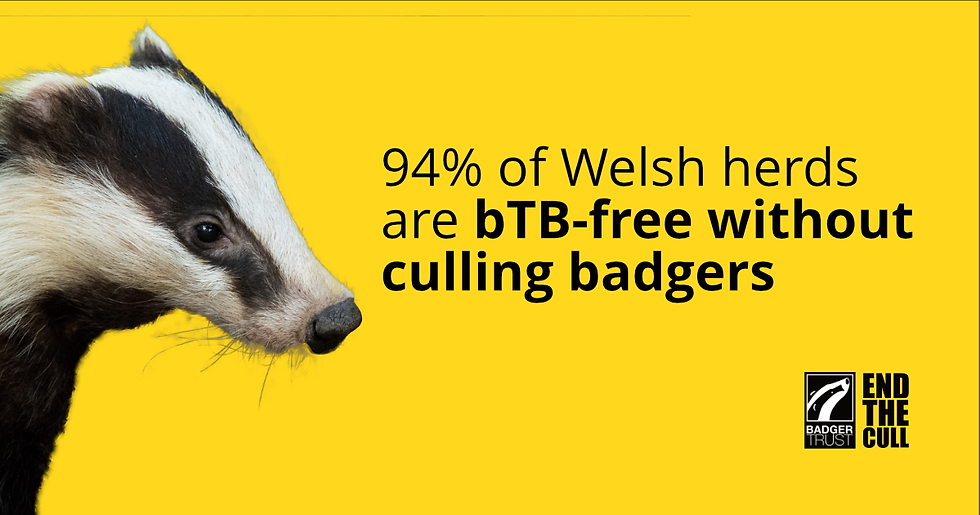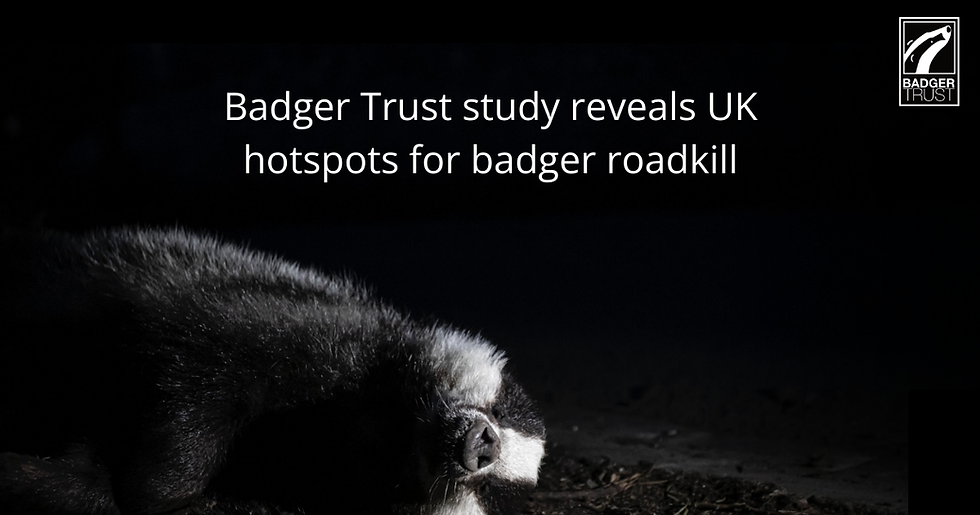94% of Welsh herds are bTB-free without culling badgers
- Badger Trust Staff Team

- Apr 18, 2023
- 5 min read
Updated: Apr 24, 2023
Whilst England needlessly culls 210,000 badgers, Wales protects both cattle and badgers.
Animal welfare supporters across Britain were saddened and exasperated by the sobering news issued by Defra officials on Thursday, 5 April 2023 that over 210,000 badgers have now been killed in England – that’s up to half of Britain’s estimated badger population, and all in the name of an ill-conceived strategy to control Bovine Tuberculosis (bTB).
Yet just days before Defra confirmed the death of 210,000 badgers in England, the Welsh government confirmed that 94.7% of Welsh herds are TB-free without killing badgers.

In this article, we review what we know about the link between bTB and badgers and how to manage this devastating disease without the lethal control of a protected native species.
Bovine TB and badgers
There has been a longstanding controversy surrounding the role of badgers as a wildlife vector in the spread of bTB. Although some call for the lethal control of badgers as a part of disease management, research has shown that badger-to-cattle bTB transmission is extremely rare. In fact, 94% of bTB is transmitted from cattle-to-cattle.
Badgers are also not the only other non-bovine species that can carry bTB. It’s been found in deer, rats, foxes, goats, and domestic cats. The most likely way badgers, or any other wild or free-roaming animal, could spread bTB to cattle would be through contamination of cattle areas. Therefore, farm biosecurity, preventing wildlife from entering farm buildings, is the most effective measure to protect cattle and wild animals from passing the disease to each other. Since bTB is most prominently passed between and within the herd, restricted cattle movements, sanitary farm husbandry, and reliable and frequent cattle testing, are the most essential measures, particularly in the absence of a cattle vaccine. The effectiveness of cattle-based measures is evident today. We only need to look at England’s neighbouring Welsh counties that are managing bTB successfully without culling badgers.
How does bTB policy differ between England and Wales?
In England, badger culling has been part of a series of bTB control measures since the current policy was implemented in 2013. What started as just two trial areas has now dramatically expanded. Badger cull zones now take up a staggering one-third of land in England. And still, bTB persists in cattle throughout the country. Why? Because biosecurity measures are optional, cattle testing is poorly implemented, and the SICCT cattle bTB test, which is mandatory in England, is highly unreliable. In Wales, bTB control policy is strictly cattle-focused, culling badgers is prohibited, and cattle testing is much more efficient. Welsh herds are tested with a combination of tests (including Interferon-gamma and IDEXX blood tests to gain more reliable results). Testing is also more frequent, cattle movements are more strictly controlled, and farm biosecurity is linked to farmer compensation. What does this mean? Farmers will not be fully compensated for cattle that test positive for bTB if they have not abided by rules on cattle movement or other biosecurity measures. No such compliance with biosecurity best practices is required in England for farmers to be eligible for compensation. Whereas in England animals other than cattle are not routinely tested for bTB, in Wales badgers, deer, and other livestock species, are tested for bTB as well as cattle. Instead of indiscriminately killing badgers, Welsh badgers are protected from disease via vaccination in focused areas.
Welsh research has also shown that infected badger populations most commonly contract bTB from cattle. No such tracing of disease is routinely conducted in England. Badger kill targets are not linked to the number of infected animals because badgers are not routinely tested for disease either before or after culling. Not to mention that culling badgers has been proven to be ineffective at reducing bTB in cattle. Overall, the approach in Wales involves following the science; tracing the disease, targeting measures on the most important transmission routes, and providing leadership to farmers who are instructed on what rules to follow.
In England, however, policymakers place the responsibility onto individual farms. Other than compliance with unreliable testing and some (albeit patchy) restrictions to cattle movement, it is up to each farmer which approach to implement, whether it be biosecurity, badger culling, or badger vaccination. This results in a mixed picture of disease management which is confusing, complicated, and ineffective.
Without government leadership via mandated policies, farmers lack direction to know what to do to best protect their cattle. Farmers also have little financial support or incentive to implement cattle-based measures.
At the cost of £100 million per year, England’s failing bTB strategy is falling on the shoulders of taxpayers and farmers. Yet the ultimate price is paid by badgers.
Is the strategy in Wales working?
In March 2023 the Welsh government confirmed that 94.7% of Welsh herds are TB-free without killing badgers. The 2023-2028 Wales TB Eradication Programme Delivery Plan shows that between 2009 and December 2022, new TB incidents fell by 49% in Welsh herds while prevalence decreased by 32%. And by December 2022, 94.7% of herds were TB-free, all whilst protecting badgers rather than killing them.
Welsh statistics confirm that quarterly TB herd rates across Wales continue to steadily decline in response to their cattle-focussed disease management strategy. And even in high-risk areas of Wales, the herd incidence of bTB is decreasing. Whilst several areas in Wales have experienced higher disease incidences, these areas are subject to increased surveillance and additional targeted measures. They are also not significant enough to impact the country-wide trend in bTB reduction. After consultation with farmers last year, the Welsh government is now implementing further farm assistance. Additional measures include risk-based trading so farmers can make informed decisions when purchasing their cattle. No such strategies are being implemented in England.
Speaking of the successes seen in Wales and what this could mean for badgers in England, Peter Hambly, Executive Director of Badger Trust, remarked:
“Wales shows you should focus on cattle to reduce bovine Tuberculosis.
“This has always been the case, yet English policy focuses on killing badgers with disastrous effects on the badger population whilst being ineffective in the spread of bTB. This is because bTB is a mainly cattle-to-cattle transmitted disease. By not culling badgers, Wales shows a more effective and humane way forward.”

What can we learn from Wales?
The biggest take-home message from the latest Welsh statistics is that badger culling is unnecessary to reduce rates of bTB in cattle herds. It is possible to reduce bTB in cattle by focussing on cattle-based measures. Yet farmers must be guided by clear and scientifically justified mandatory measures.
Overall, Wales has shown that there is a world in which wildlife and cattle can coexist and where farming industries can be protected. The huge success seen in Wales has proven that a scientific, effective, and humane bTB control strategy is the way forward. Badger Trust implores English policymakers to follow suit on these cattle-based measures to secure a sustainable, bTB-free future.



